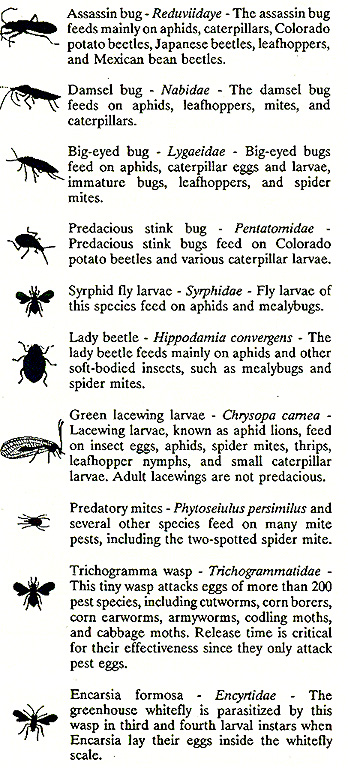 Soil Preparation
Soil Preparation
 Plant Selection
Plant Selection
 Cultural Practices
Cultural Practices
 Encourage
Beneficial Insects
Encourage
Beneficial Insects
 Beneficial Insects
and Mites
Beneficial Insects
and Mites
 Chemical Controls
Chemical Controls
Soil Preparation
The best way to control insects and disease problems is to prevent them.
Maintain a slightly acid soil (around pH 6.5). If in doubt, have a soil
analysis done through your local Extension office, by a private lab, or with a
commercial soil test kit.
 Build a biologically active, healthy soil
through regular addition of organic matter, such as yardwaste, compost, and
manure.
Build a biologically active, healthy soil
through regular addition of organic matter, such as yardwaste, compost, and
manure.
Grow winter annual cover crops, such as clover or rye grass, to provide
additional organic matter.
Till the soil in the fall to expose pests living near the surface to natural
enemies and weather, and to destroy insects in crop residues.
Return to Table of Contents
Plant crops that are suited to the soil and climate. If you do plant
vegetables or fruits that are not normally grown in your area, provide them with
necessary conditions.
Use disease-free, certified seed, if available.
Select insect- and disease- resistant vegetable and fruit varieties, when
available.
Select sturdy plants with well-developed root systems. Diseases and insects
in young seedlings may start in greenhouses or plant beds and cause heavy losses
in the garden.
Buy plants from a reputable grower who can assure you that they are disease-
and insect-free, or grow your own from seed.
Return to Table of Contents
The most effective and most important of all practices is to observe what is
going on in the garden. Many serious disease or insect problems can be halted or
brought under control early by the gardener who knows what to look for and
regularly visits the garden for trouble -shooting.
Water in the morning so plants have time to dry before the coot evening. Drip
irrigation systems prevent foliage from getting wet at all when watering.
Use interplantings in the vegetable garden as opposed to solid plantings of a
crop. This can slow the spread of diseases and insects, giving you more time to
deal with them if they occur.
Space plants properly and thin young vegetables to a proper stand.
Overcrowding causes weak growth and subsequent insect and disease problems.
Keep down weeds and grass. They often harbor pests and compete for nutrients
and water. Leaf mulches are extremely effective for weed control.
Use a mulch to reduce soil splash, which brings soil-borne diseases into
contact with lower leaves.
Rotate your garden plot, if you can. Do not grow the same kind of produce in
the same place each year. Use related crops in one site only once every three or
four years.
Avoid injury to plants. Broken limbs, cuts, bruises, cracks, and insect
damage are often the site for infection by disease- causing organisms.
Stay out of the garden when the plants are wet with rain or dew to prevent
spreading diseases.
Do not use tobacco products, such as cigarettes or cigars, when working in
the vegetable garden. Tomato, pepper, and eggplant are susceptible to a mosaic
virus disease common in tobacco and may be spread by your hands.
Remove and dispose of infected leaves from diseased plants as soon as you
observe them. Remove severely diseased plants before they contaminate others.
Clean up crop refuse as soon as you are finished for the day.
Keep old sacks, baskets, decaying vegetables, and other rubbish, which may
harbor insects and diseases, out of the garden.
Staking tall flower and vegetable plants or planting them in wire caves
prevents the blossoms or fruit from coming in contact with the soil.
Time plantings in such a way that the majority of your crop will avoid the
peak of insect infestations. For example, plant squash as early as possible to
avoid borers, which lay eggs in July. Keep a record of the dates insect problems
occur.
Plant warm-weather crops after the soil has warmed to avoid problems with
seed and root rots; growth will be more vigorous, as well.
 Inspect plants for egg clusters, beetles,
caterpillars, and other I insects as often as possible. Hand-pick as many pests
as you can. Avoid sprays until the population of insects has reached a critical
level.
Inspect plants for egg clusters, beetles,
caterpillars, and other I insects as often as possible. Hand-pick as many pests
as you can. Avoid sprays until the population of insects has reached a critical
level.
Where slugs are a problem, use traps and try to create drier conditions.
Heavy mulches may sometimes encourage slugs. Spread crushed eggshells or
hydrated lime around affected plants.
Enlist the aid of birds in your garden. Overall, they do more good than harm.
Consider planting shrubs and trees with fruits that attract them. Keep in mind,
however, if you attract wild birds, you will have to protect ripening fruit (and
even some vegetables) by using bird netting or scare devices (aluminum pans
banging in the breeze are fairly effective).
Return to Table of Contents
Naturally occurring predators and parasites are found in gardens, orchards,
and fields. Learn to properly identify these species as benefits of your
environment. Avoid using pesticides around them. They are as susceptible to
insecticides as the pests.
Return to Table of Contents

Return to Table of Contents

If a pest problem requires chemical controls, use the least toxic materials
according to the label. A certified nurseryman or Extension agent can help you
identify the proper pesticide and the method to use it.
Return to Table of Contents
![]() Gardeners' Corner
Kids'
Garden
Sustainable Garden
Contact Us
Gardeners' Corner
Kids'
Garden
Sustainable Garden
Contact Us![]()



 Build a biologically active, healthy soil
through regular addition of organic matter, such as yardwaste, compost, and
manure.
Build a biologically active, healthy soil
through regular addition of organic matter, such as yardwaste, compost, and
manure.  Inspect plants for egg clusters, beetles,
caterpillars, and other I insects as often as possible. Hand-pick as many pests
as you can. Avoid sprays until the population of insects has reached a critical
level.
Inspect plants for egg clusters, beetles,
caterpillars, and other I insects as often as possible. Hand-pick as many pests
as you can. Avoid sprays until the population of insects has reached a critical
level. 
